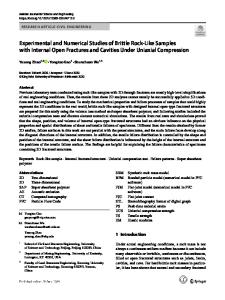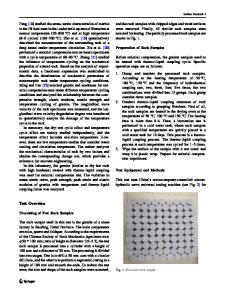Experimental Study of Electric Potential Response Characteristics of Different Lithological Samples Subject to Uniaxial
- PDF / 6,852,115 Bytes
- 12 Pages / 595.276 x 790.866 pts Page_size
- 4 Downloads / 317 Views
ORIGINAL PAPER
Experimental Study of Electric Potential Response Characteristics of Different Lithological Samples Subject to Uniaxial Loading Zhonghui Li1,2,3 · Xin Zhang1,3 · Yang Wei1,3 · Muhammad Ali3,4 Received: 15 November 2019 / Accepted: 11 October 2020 © Springer-Verlag GmbH Austria, part of Springer Nature 2020
Abstract Electric potential (EP) signals are detected when coal or rock materials are subjected to mechanical loading. Such signals are attributed to the generation and accumulation of free charges under externally applied loads. Due to the excellent correlation between EP and damage evolution, EP methods have great potential in rock mass structural engineering damage monitoring. To systematically study the EP response of different materials, four kinds of samples were prepared for experiments. Moreover, the coefficient of variation (CV) and correlation coefficient were introduced to study the EP response characteristics in different loading stages. Furthermore, characterizations based on atomic force microscopy (AFM), scanning electron microscopy (SEM), and X-ray fluorescence (XRF) were used to reveal the reasons for electrification from a microproperty perspective. The results showed that the EP response characteristics were dominated by the main electrification factors in different loading stages, while these factors were influenced by the microstructure and composition of the different samples. Additionally, crack propagation was a significant mechanism for the EP response, which included electron escape induced by stress concentration at the crack tip, charge separation due to crack propagation, and discharge in the crack tip. Finally, the surface potential was a critical EP generation factor. Different samples were characterized by weak electrical properties in the 5 μm × 5 μm scanning area, and the unevenly distributed surface potential regions can affect the accumulation and migration of the free charges. This study offers new insights into the EP response characteristics and the causes of electrification from macro- and microperspectives. Keywords Electric potential · Different lithological samples · Electrification reasons · Crack propagation · Surface potential
* Zhonghui Li [email protected] Xin Zhang [email protected] Yang Wei [email protected] Muhammad Ali [email protected] 1
Key Laboratory of Coal Mine Gas and Fire Prevention and Control of the Ministry of Education, China University of Mining and Technology, Xuzhou 221116, Jiangsu, China
2
State Key Laboratory of Coal Resources and Safe Mining, China University of Mining and Technology, Xuzhou 221116, Jiangsu, China
3
School of Safety Engineering, China University of Mining and Technology, Xuzhou 221116, Jiangsu, China
4
Department of Mining Engineering, Balochistan University of Information Technology, Engineering and Management Sciences, Quetta, Pakistan
1 Introduction Rock damage and unstable failure are critical issues in rock mechanics that pose a tremendous threat to the safety of human lives and pr
Data Loading...











